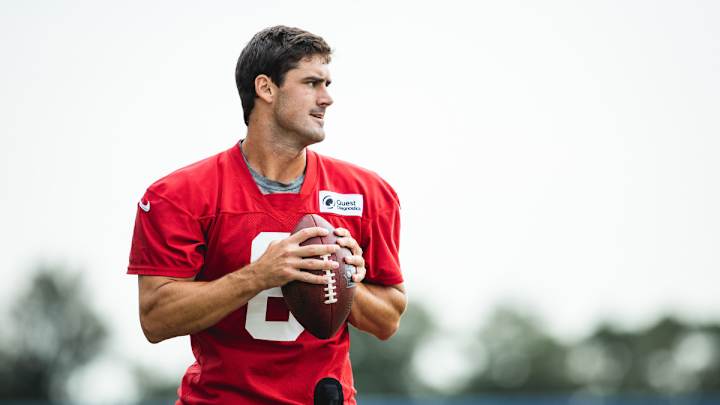Daniel Jones Hopes to Follow the Success of Other NFL Quarterbacks Who Have Bulked Up

When it comes to Giants quarterback Daniel Jones, it's hard to find anyone who isn't anticipating the second-year pro to have a big season in 2020.
Jones, to his credit, isn't leaving anything to chance either. Besides immersing himself in learning every single nuance of the Giants new offense that will be run by offensive coordinator Jason Garrett, Jones went through an intense off-season workout program that boosted his 2019 playing weight from 220 pounds to 229 pounds.
"I wanted to get stronger and wanted to gain some weight for what that does for every part of my game," Jones said. "Standing in the pocket, running when I need to, and obviously throwing the ball as efficiently as I can, using my strength, my lower body. Each piece of that was part of the goal of the offseason in my training."
If history is any indication, Jones' decision will ultimately prove to be the right one in terms of durability and his throwing motion.
Last July, Baltimore Ravens quarterback Lamar Jackson revealed that he added up to 10 pounds from his rookie year.
Lamar Jackson on adding muscle this offseason: pic.twitter.com/sYBcgD6lul
— Baltimore Ravens (@Ravens) July 26, 2019
Jackson went on to earn NFL MVP honors, leading the Ravens to a 14-2 record and the highest-scoring offensive output in the NFL. His strength even showed up on his passing and rushing stat lines.
Statistically, Jackson's second-year growth saw an increase in yards-per-carry from 4.7 in 2018 to 6.9 in 2019, the most by any quarterback.
The added muscle might have even played into Jackson's improved rushing yards after contact, going from 1.3 in 2018 to 1.9 in 2019, as with added bulk, he became harder to bring down upon initial contact.
Jackson's deep-ball completion also benefited as well. According to PFF, Jackson boosted his adjusted deep-ball completion percentage from 38.5% as a rookie to 41.8% last season.
Perhaps most encouraging of all is that Jackson was able to significantly improve his ball security, something that no doubt will catch the attention of the Giants fans that cringed when Jones became something of a turnover machine last year.
As a rookie, Jackson only started seven games, but he led the league in fumbles with 12. Jones displayed comparable fumbling issues as a rookie last year, with a league-leading 18 fumbles in 13 games.
Jackson's fumbles were technically even more frequent than Jones based on their sample size of playing time. So assuming Jones also worked on grip strength as part of his workout program, there is hope that this year he'll see a reduction in fumbles as Jackson, who cut down his fumbled to nine last year, did.
Another quarterback who benefited from a weight gaining workout program is Detroit's Matthew Stafford. Stafford, the No. 1 overall pick in the 2009 draft, missed 19 games his first two NFL seasons to injury.
During the 2011 offseason, Stafford added approximately 10 pounds of muscle during his rehab assignment after undergoing shoulder injury in January. He emerged with a noticeably thicker frame, especially in his upper body during training camp that year.
With his bulkier frame, Stafford stayed healthy and didn't miss a start for the next eight seasons until missing eight games with a fractured bone in his back last year.
While Jones is still early in his career, he's already missed two games in his rookie season due to a high ankle sprain, an injury that resulted when he was quickly pulled down on a scramble attempt. By improving his base and his legs, the hope is that Jones will be tougher to drag to the ground when he becomes a runner.
Jones seems to have taken the right steps toward limiting injury risk this offseason, just as Stafford, who in 2011, played his first complete 16-game season and led the Lions to the playoffs for the first time 12 years, did.
From a performance perspective, Stafford emerged as one of the best deep-ball throwers in the NFL after adding the extra muscle. That year alone, he completed 13 touchdown passes on passes further than 15 yards down the field. He also made history as the fourth quarterback in NFL history to throw for over 5,000 yards in a single season.
Jones proved to have deep-ball potential himself as a rookie despite criticisms of his arm strength by draft experts, but still has room for improvement.
Jones had 54 deep attempts, with 16 completions and three drops (adjusted completion percentage of 35%), and he threw for 498 yards with nine touchdowns and four interceptions in 2019.
With extra arm strength, Jones might be able to build on those numbers just as Stafford and Jackson were able to after adding extra muscle early in their careers.
And if these examples aren't convincing enough, look no further than the Giants now retired iron man, Eli Manning, who never missed a game in his career due to injury. Every off-season Manning would hit the weight room hard to ensure his strength was on par with that of a running back.
He also took a big jump forward from his rookie campaign, the added strength and conditioning enabling him to withstand some brutal hits over the years from which he simply bounced back up.
Get the latest Giants news by joining the community. Click "Follow" at the top right of Giants Country page. Or sign up to receive our free daily newsletter.
